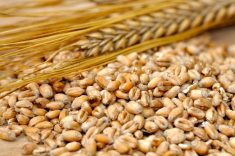MarketsFarm — If traders and analysts are correct with their estimates, there will be slightly more wheat and canola acres seeded in Canada this year compared to 2022.
Statistics Canada (StatCan) will release its first survey-based acreage estimates for the 2023-24 marketing year on April 26. Other than drier and cooler conditions in southern Manitoba, the weather outlook for Western Canada appears to be similar to last year. However, other factors such as the potential for flooding in the Red River Valley and volatile global prices could have effects on acreage.
Read Also

U.S. livestock: Feeder cattle hit contract highs on tight supply
Chicago | Reuters – All Chicago Mercantile Exchange feeder cattle futures and most live cattle futures hit contract highs on…
“As long as we don’t get extremely regular or large amounts of precipitation in May, we should be able to get the crop planted in a decent manner,” MarketsFarm expert Bruce Burnett said. “Our soil moisture situation will be good, but we don’t have excess soil moisture on the eastern Prairies.”
Agriculture and Agri-Food Canada (AAFC) released its monthly principal field crops report on Friday, including its own acreage estimates for 2023-24.
Pre-report trade estimates show that most crops may see little change in the number of acres seeded this spring compared to last. The trade believes there will be on average 22 million acres seeded for canola, a slight increase from 21.4 million last year.
MarketsFarm analyst Mike Jubinville said that canola’s high prices and falling fertilizer costs may make the crop more appealing to growers and he projects 22 million acres for the oilseed.
“While canola prices have come off their ultimate highs, in a relative sense, everything else has dropped off as well,” Jubinville said, adding that 22 million is around the maximum number of acres for Western Canada to seed before growers opt out of rotation. “The return-on-investment potential with canola is still strong enough to maintain acres.”
Acres for all wheat varieties are expected to total anywhere between 25.5 and 27 million according to trade estimates. The projected increase in area from the 25.4 million acres seeded in 2022 has to do with more spring wheat acres anticipated at the expense of oats, pulses and durum. Burnett and Jubinville estimated all wheat acres to total 26.17 million and 27 million, including 18.7 million and 19.25 million for spring wheat, respectively.
“You’re looking at spring wheat prices in the $10-$11 (per bushel) area, (they’re) off from last year. But historically speaking, very strong prices,” Jubinville said.
Ken Ball of Winnipeg-based PI Financial is predicting 26.5 million acres for all wheat varieties, including 19.2 million for spring wheat.
“Many growers posted their highest yields in history for spring wheat (last year), by a long shot in some cases,” he said. “I think growers are just finding wheat is a little bit more reliable to grow than canola.”
While most analysts believe durum acres will dip below the six million mark achieved last year, Jerry Klassen of Resilient Commodity Analysis in Winnipeg believes growers will stick to what they know and add an additional 100,000 acres.
“The farmers that can grow durum in the durum (growing) areas, they’re sticking with durum because of the favourable returns (from last spring),” he said.
Meanwhile, the number of barley acres could rise as much as 600,000 this year from the seven million planted in 2022. Klassen pegged the seeded area for barley to total 7.3 million acres, with some hesitancy.
“I think right now people are anticipating barley exports are going to be down sharply from last year. So we’re going to be focused on the domestic market to set a price for barley,” he said. “But it’s cheaper to grow and you can still get pretty good yields whether it’s dry or wet.”
The consensus from the trade is that oat area will be cut significantly this year. Due to a large carryout from last year and falling prices, growers are less inclined to seed the cereal crop this year. Canadian oat acres are expected to decline anywhere between 340,000 and 1.14 million from the 3.94 million planted in 2022.
“The acres were big because the price potential for oats was so extraordinary last year. But that has fallen right off the table and I think growers are going to abandon it in a big way,” Jubinville said, while also predicting 2.8 million acres for oats.
Table: A recap of pre-report expectations, with Agriculture and Agri-Food Canada’s (AAFC) April 2023 acreage estimates and Statistics Canada’s acreage totals for the 2022-23 marketing year provided for comparison purposes. Figures in millions of acres.
| Trade | AAFC, | StatCan, | |
| Crop | projections | 2023-24. . | 2022-23 |
| Barley | 7.000 – 7.660 | 7.413 | 7.045 |
| Canola | 21.650 – 22.300 | 21.745 | 21.396 |
| Corn | 3.650 – 4.200 | 3.581 | 3.624 |
| Flax | 0.625 – 0.770 | 0.741 | 0.779 |
| Lentils | 3.900 – 4.200 | 4.275 | 4.321 |
| Oats | 2.800 – 3.600 | 3.059 | 3.937 |
| Peas | 3.050 – 3.310 | 3.212 | 3.368 |
| Soybeans | 5.070 – 5.660 | 5.634 | 5.274 |
| All wheat *. . | 25.500 – 27.000. . | 25.845 | 25.388 |
| Durum | 5.700 – 6.100 | 5.674 | 6.006 |
* – “All wheat” includes spring wheat, durum wheat, and winter wheat remaining after winterkill.

















